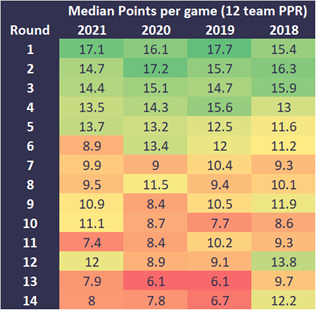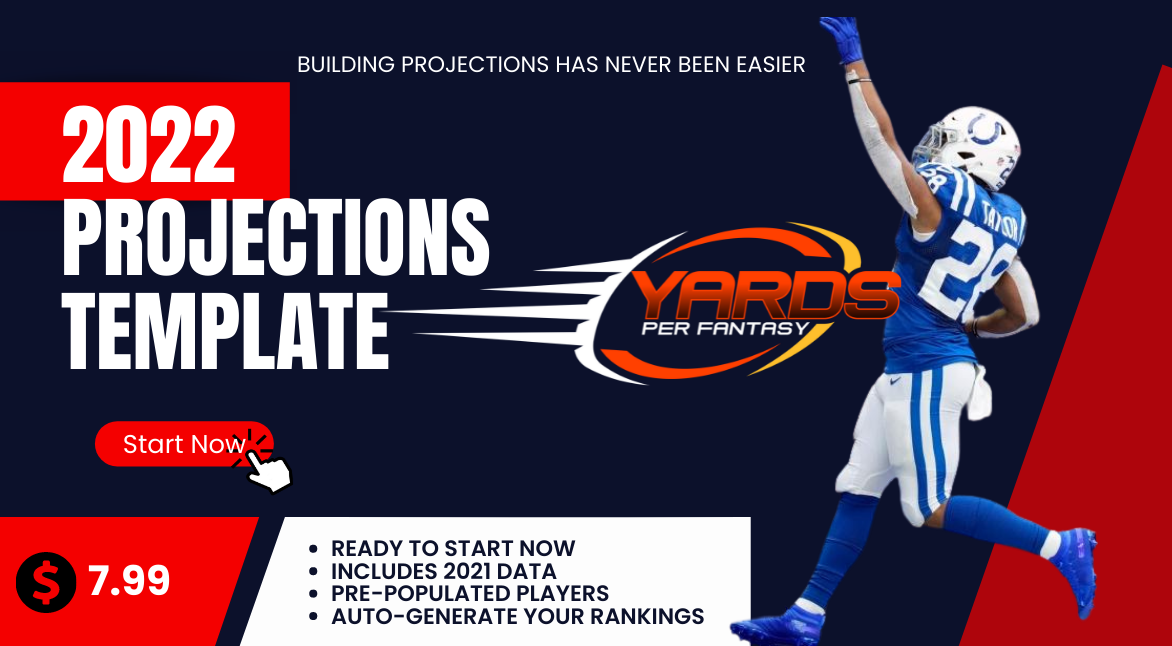 Draft With Us On Underdog! Use Promo-Code: YARDSPER for a 100% deposit match up to $100!
Draft With Us On Underdog! Use Promo-Code: YARDSPER for a 100% deposit match up to $100!
It’s a common idea in fantasy football circles that you don’t win your league on draft day. Sure, it’s the foundation piece of your season but there’s waivers, trades, and start/sit decisions to make throughout the season. If you’re like me, you’ve been in a league with someone who autodrafts an amazing starting team and somehow does ok despite not logging on to the platform for most of the season. But rarely do they actually ride that fortunate autodraft to a championship. That’s the proof of concept, you don’t win your league on draft day.
So, can you lose your league on draft day? It’s the same principle: with all the in-season moves available (waivers, trades) your place in the league isn’t set once the draft is done. However, you can give yourself an uphill climb with the wrong move or some bad luck.
Where’s the advantage?
I looked at which rounds of the draft truly give you an advantage and therefore, which rounds you really don’t want to mess up.
For this exercise, I took ADP data from Fantasy Football Calculator and I removed all players except for Running Backs, Wide Receivers and Tight Ends (so I didn’t skew the numbers with Quarterbacks, Kickers or Defenses). I then put the PPR Points Per Game scored against each player and took the median for each round. In other words, what was the median of points scored from players drafted in each round.
Point of order: I took Points Per Game over total points in order to remove the injury luck. You can’t say it was bad drafting to take CMC last season, just bad luck.

The above table is a summary of the findings. As you can see, and as you’d probably expect, the early rounds offer players with higher points than later rounds.
It differs somewhat year to year but there’s a drop-off somewhere around rounds 4-5, and around 13 PPR points per game.
So what does this tell us?
It tells us that the median outcome (basically being the most expected outcome) through the first 4-5 rounds of the draft has a significantly better result than the rest of the draft. Sure there are some outliers in some later rounds but they’re all over the place, they’re not predictable and we can’t rely on them. What we can rely on is, if the median outcome from the first few rounds is upwards of 13 PPR points per game, then most of your leaguemates are coming out of the draft with 4-5 of those players. That means if you DON’T come out of the draft with 4-5 of those players, you’re behind the 8-ball to start with. All of a sudden, instead of needing 1 or 2 shrewd moves to win your league, you need 4 or 5. You haven’t lost your league, but you’re at a serious disadvantage.
But Matt, doesn’t it work the other way? If you draft a league-winning player in one of these rounds then don’t you give yourself an advantage over the rest of the league?
Yes you do, but even if you know 100-percent who those players are going to be, that doesn’t mean they won’t get drafted ahead of you by others in your league. Just as a reminder, Jonathan Taylor and Cooper Kupp were drafted in rounds 2 and 4 respectively last season. They weren’t players touted as those league-winners, otherwise they would have been drafted in round 1.
So if those league-winners can come from random spots (and that’s what a look back over the last few years shows) then you need to start by making sure you’re at least maintaining pace with the rest of your league through the first 4-5 rounds of the draft so you’re in a position to take the next step in winning your league. And that doesn’t mean you don’t draft a player who you think can win your league, you still should absolutely do that, but they need to be a player who is also going to give you at least that 13 PPR points per game most weeks.
What volume do we need?
Ok, so we’ve established you need to draft players with a 13 PPR points per game floor through the first part of the draft. What does that look like?
When I put together the players that hit that mark in 2021, there were some benchmarks that most of them hit.
- Running Backs need 15 touches per game (rush attempts and receptions)
- Wide Receivers and Tight Ends need 7 targets per game (unless they’re on a bad passing offense and then you need to bump that number up a bit)
This is useful in my mind. This means we can identify the players who would definitely get that workload and those with the potential. Remember, we need this output as the floor through the first 4-5 rounds so you should ONLY be drafting players with a very high likelihood of hitting these numbers.
That means running backs who have a solid role on their team, it means pass-catchers who are clear number one on their team, and it means pass-catchers who are number two with a solid role on a high volume team.
If they don’t have this volume as their likely outcome then there’s a chance they bust and put you at a disadvantage in your league.
Follow the logical extension here, we still want league winners so if we can identify the players with this volume as their floor but with potential for much bigger upside, they should be the priority. But if the choice is between a player who is most likely getting this level of work, or a player whose range of outcomes is either monster workload or next to nothing, then don’t take the risk at this point of the draft.
Now of course, when the players with this level of likely workload start drying up that’s when you start to draft those high risk / high reward players. As you can see from the earlier table, the median difference in players after this point doesn’t differ greatly from round to round so you can afford to take some risks and then replace those players if they bust. That’s also why this is a good spot to start taking Quarterbacks and Tight Ends, when you’re no longer passing on RBs and WRs who would give you that 13 PPR points advantage.
Thinking about it this way also gives you an idea of what to do in later rounds. If you see a player in later rounds who looks absolutely set for that 13 point volume then they’ve clearly dropped too far and you just grabbed yourself a bargain.
For Clarity
- Priority 1 – 13 point floor with upside
- Priority 2 – 13 point floor
- Priority 3 – Upside
What this also means you DON’T do is trying to hit the right player from a committee during these rounds. That might be a committee running back or could be trying to find the right Green Bay wide receiver who is going to become Aaron Rodgers new BFF. Yes if you hit the right one that could be a league-winner but the time and place for taking that shot is when the types of players we mentioned above have all gone off the board.
Point of order (another one): I noted above the results were based on a 12 team league so if the size of the league differs, those rounds will move. If your league has 14 or more teams those rounds will dry up sooner, if your league has 10 teams or less then you might get an extra round or two.

Half-PPR
When you get in to half-PPR, the criteria should be similar but the drop off is closer to 11 points per game rather than 13.
Other Strategies
When you get your head around this concept of needing those returns from those rounds of the draft, a lot of other things start to fall in to place. There’s all these strategies flying around that people tout and all these reasons they use to support them but fundamentally it comes back to this principle. Those strategies work when they exploit the value from this concept. Other analysts say not to pick a specific strategy but to go with the value on the draft board and guess what, it comes back to this same principle again: it’s the value on the draft board based on availability of the players that fit our requirements.
RB Deadzone
I recently released an article about the running back deadzone and whilst it doesn’t necessarily align with the expected rounds of the deadzone here, the players drafted in the first 4-5 rounds who failed to reach the 13 point mark were mostly running backs. The theory therefore extends and perhaps starts to explain the deadzone further: the running backs in this range don’t have 13 PPR points per game as their likely outcome, that’s why most of them don’t work out.
Zero RB
If you haven’t heard this one, hold on tight through the offseason because this always gets plenty of debate. The theory: don’t draft a running back until later in the draft, load up on WR and other positions instead. There’s lots of conjecture as to whether it works but if you think about the concept here, if there aren’t running backs available to you in the first few rounds with that 13 point floor and some upside then you can see how they get passed on for other players who do fit that criteria.
Late Round Quarterback
Another strategy born from the idea that you get a better advantage from running back and wide receiver through the first part of the draft and that the drop in points to Quarterbacks later in the draft is not significant, so you can wait to draft them. Again, lets extend this theory: if you pass on a player with a 13 point floor in the first few rounds to draft a Quarterback then your leaguemates gain an advantage at one of those positions. The only reason therefore to do this would be if the Quarterback you’re drafting has an even larger advantage over the replacements available later in the draft.
Projections
If you’re shifting your mindset towards a player’s potential volume, then I highly recommend carrying out your own projections. It can take a little time to put together but you’ll end up very surprised by the results. And even if the results aren’t quite what you expected, the process of doing them will enlighten you along the way.
Take the Philadelphia Eagles for example. You might look at them and think AJ Brown and Devonta Smith are both great wide receivers who are going to get enough volume to hit those floors we need. But when you go through projections and start to compile the team’s likely play volume, how much they pass versus rush the ball, and who is vying for targets, you’ll soon see that they run the ball too much to have two viable pass-catchers in the team.
PROJECTIONS TEMPLATE – GET NOW!
If you want to get involved in projections, which I can’t recommend enough, Yards Per Fantasy has a template that has the whole process set up for you to just input the numbers (and has 2021 data to help guide you with that part too) and I wrote a guide on how to go about the whole thing. It’s well worth the investment if you want to become a better fantasy football player.
Summary
Remember the key points:
- Through the first few rounds (generally 4-5), take the players who are likely to get the volume
- Running Backs need 15 touches per game (rush attempts and receptions)
- Wide Receivers and Tight Ends need 7 targets per game (unless they’re on a bad passing offense and then you need to bump that number up a bit)
- Take these players off the board before you start throwing darts at upside alone
- Change your mindsight to use this volume as your baseline, not an arbitrary ranking
- Do your own projections to understand who can get the volume, and how
As always, hit me up with any questions or comments!








